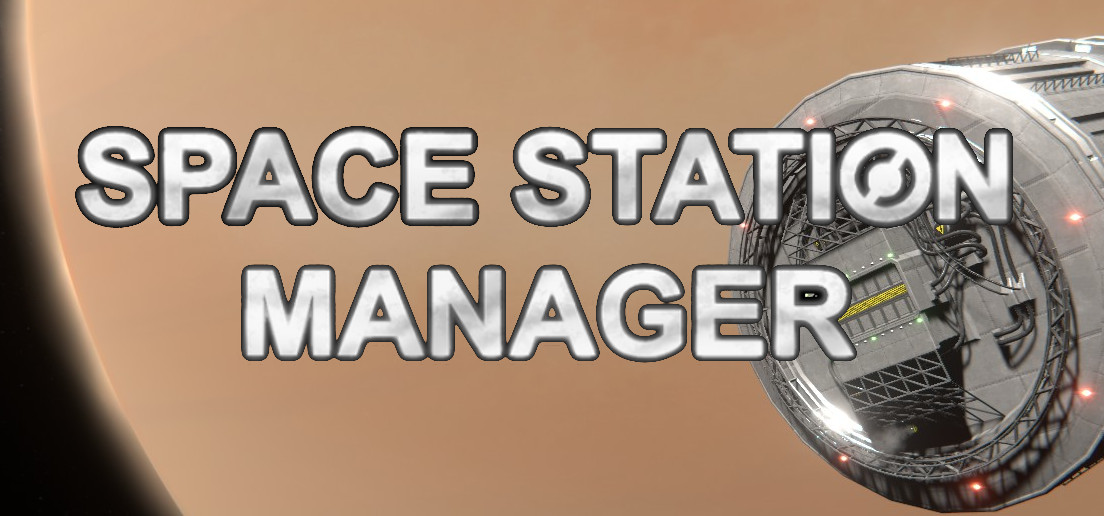Like the Hubble Space Telescope, this one launched with a vision that’s a bit too blurry…
Type: Single-player
Genre: Management, Simulation
Developer: Ondrej Hroch
Publisher: Ondrej Hroch
Release date: 6 April, 2020
Intro
Generally speaking, I don’t put much stock in “Early Access” when reviewing a game. Broadly speaking, if a game is available for customers to pay for the game, then it should be judged for what it is now, the product that a customer would be buying, rather than what we are promised it will be sometime later, especially since I have no way of reviewing this hypothetical future game other than simply not doing a review until after the developers stop working upon the game, by which time it is probably too late for the review to actually be useful to anyone. (Funny how criticisms that you shouldn’t make negative reviews until after a game is “complete” tend to do that, yet the positive early reviews are just fine…)
With Space Station Manager, however, I have to make an exception to this, as I cannot really rate this game as it currently exists at all. To put it simply, if you are only interested in the question of whether the game in its current state is a complete game you will enjoy, the answer is a pretty solid “not at all”. The game lists itself as an alpha build, but this is really a pre-alpha, as most of the features of the game are either placeholders or not implemented yet at all. This game features a damage display on the interface and has missiles you can buy on the market, for example, yet has no combat system whatsoever. This is a game whose foundations are not yet fully laid down, and as such, there’s no real way to judge this game as anything but “incomplete”.
Video Walkthrough
Owing to the developer’s request, I have made my first “Let’s Play”-style video review of a game. My apologies for the audio, but I do not have a professional microphone. However, considering the limited content of the game at this time, I could manage to fit basically every currently-extant game feature into a single video.
Hard Science, Except…
I was first drawn to Space Station Manager after seeing it pop up on Steam due to binging some science and futurism videos that talk about what the foreseeable horizons of technology would be like, including what space stations and mega-structures are possible using just known modern science or technologies that are scientifically probable, such as fusion reactors.
This game appears at first glance to be set five minutes into the future, with the game starting with a few companies having put commercial space stations around the Earth and a sprinkling of solitary stations around a few other bodies in the Solar System. However, in this game, you apparently need to unlock basic technologies we actually have already, such as fuel cells that burn hydrogen and oxygen together.
Making this even stranger, the game apparently just gives up and includes Faster-Than-Light (FTL) engines on all its shuttles because it wants interstellar travel but not interstellar travel wait times. This is more than a little odd, because I apparently have to spend a lot of time researching what uranium is and designing a nuclear power plant we could have built in the 50’s, as well as going through the excruciating process of gathering and refining all the materials to make one, but FTL engines are automatic unlocks and are included for free.
(I also have to note that it’s more than slightly odd to even have things like conventional missiles in this game when you have small shuttles capable of FTL, since any ship capable of going even at sub-light relativistic speeds is capable of being a planet-busting Relativistic Kill Missile. I linked a video that helps demonstrate the scale of the energies involved:
The XKCD guy also does a thought experiment here.
TL;DR: It takes infinite energy to get any matter to light speed, and exponentially more the closer to light speed you get, which is why anything but particles like light even reaching light speed is impossible by modern understandings of physics, and anything going faster than light would therefore have more-than-infinite momentum (which is why it’s impossible) to obliterate planets or stars with.
Materialism
The major limiting factor of your space stations in this game is that the mass of your station puts a strain on the middle-most segment of your space station. The longer your station and the more massive the parts in that station, the more strain this segment will be put under.
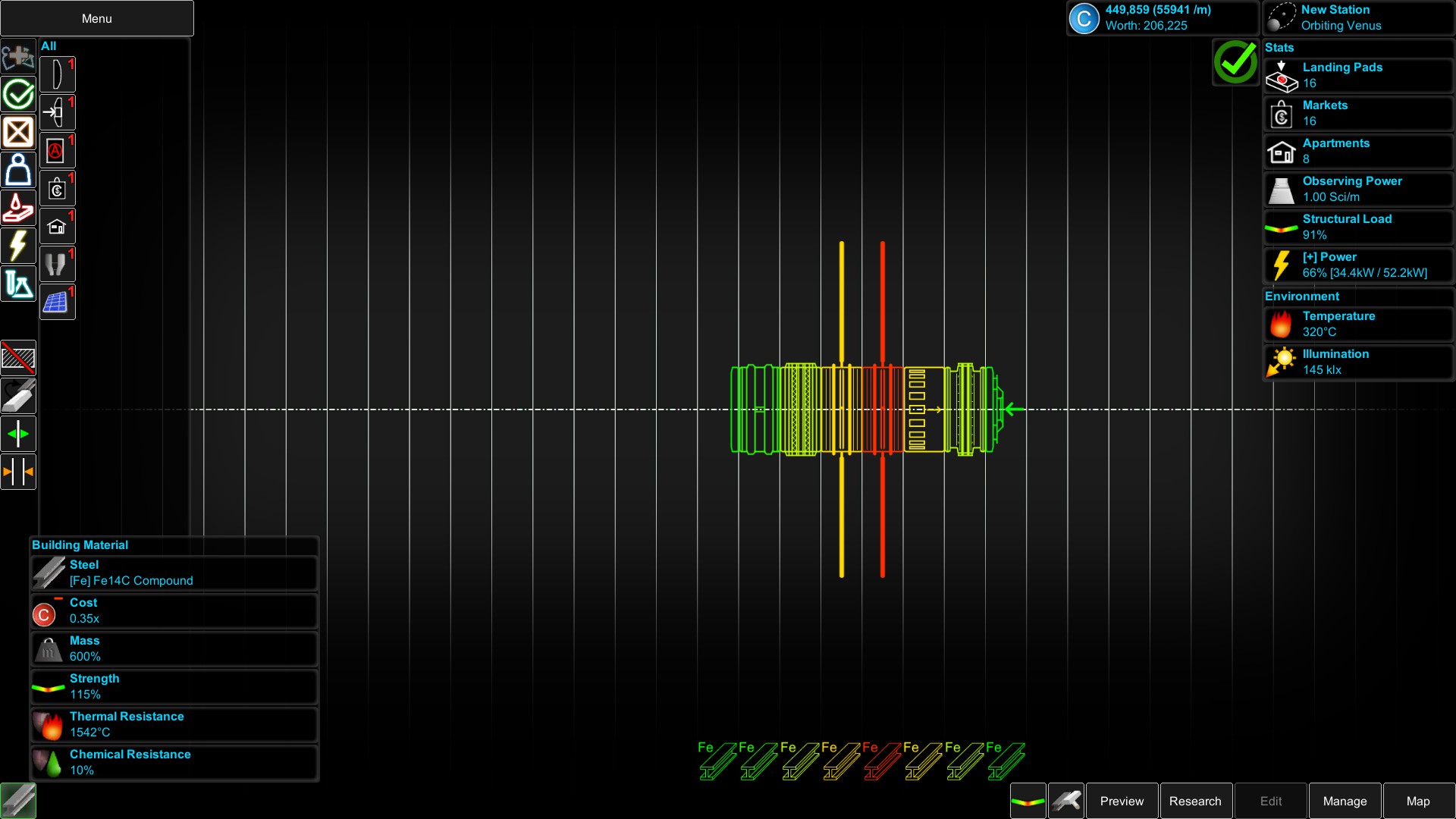
As you go up the tech tree, larger habitat pieces become available, however, at this stage in development, “large” size pieces are only filler, with only medium and small pieces having any function.
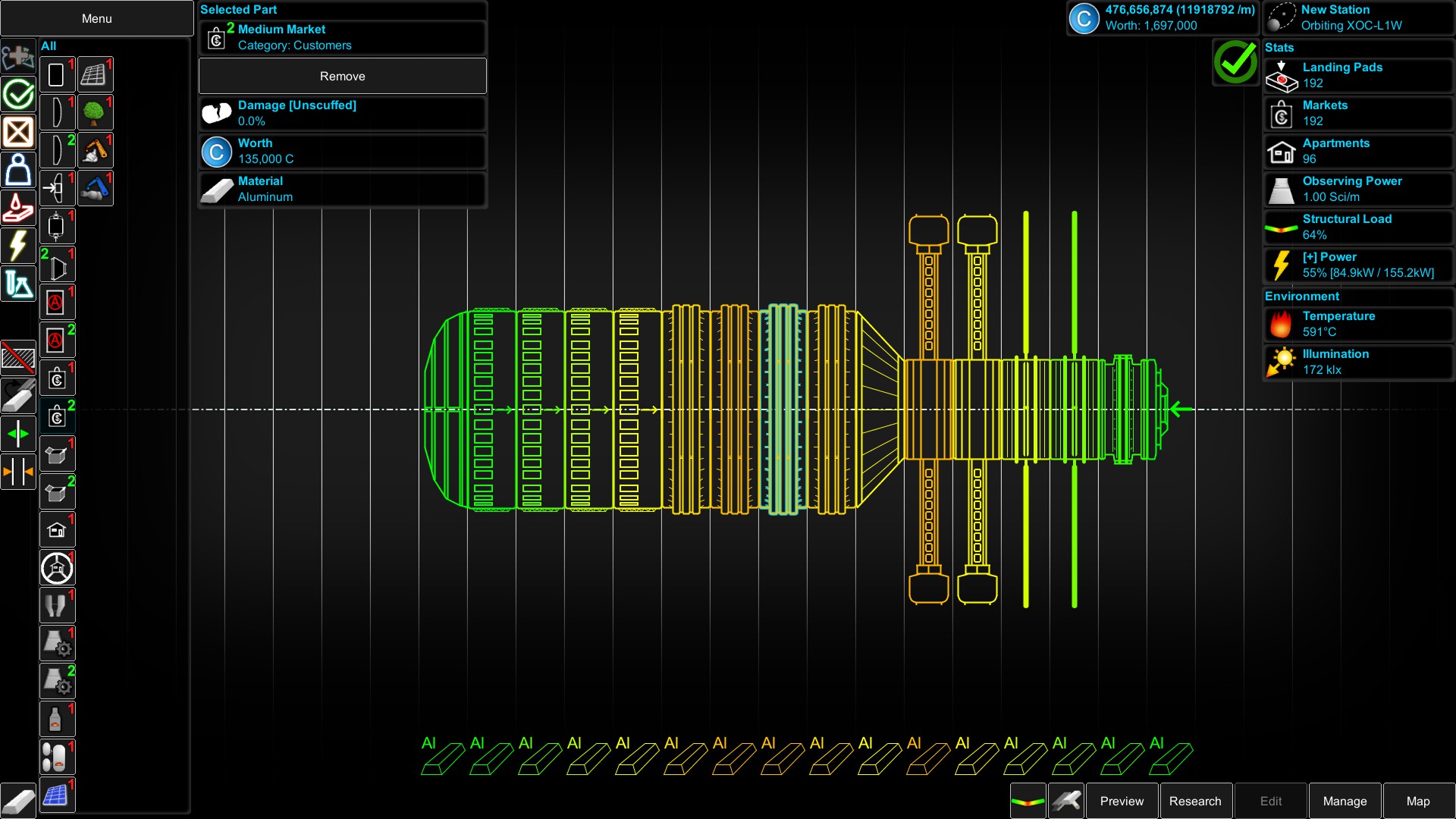
I really have no idea why the physics in this game works the way it does. This is partially simply because the game lacks any kind of manual or tutorial, but I also have no idea where the developer gets the numbers for the material properties. For example, steel is listed as six times more massive (actually “dense”) than aluminum, but actual carbon steel is only around three times as dense as most types of aluminum. It might be explained by steel needing to be twice as thick in its support beams, but steel is listed as having more tensile strength than aluminum, so that doesn’t make sense.
Likewise, in what I’ve seen of how space habitats are built, the limiting factor is not length, but width of rotating habitats. I’m no expert, I may simply be ignorant. (Although if there is math on this, why not share it with the players in a manual so the players can understand?!) That said, as I have been told, the major factor for stresses on the hull of a cylinder is how wide the cylinder has to be and how fast it rotates, especially compared to any parts that have to make up the counter-balancing spin. There’s no reason multiple cylinder habitats can’t be linked together in a chain, for that matter, effectively creating a “sausage links” configuration where passengers of one habitat can simply take a walkway over to the next. (Or have a zero-g monorail going down the central axis that transits up or down a chain of cylinder habitats, for that matter.)
Because I’m already linking videos, I might as well plug this one in, as well:
The classic type-IV O’Neill Cylinder is capable of being built 5 miles (8 km) in diameter and 20 miles (32 km) in length using steel, the worst building material in this game. While measurements are not given for the size of modules in this game, an all-steel station with a single small hotel module can house 8 people in it, so it’s probably a lot smaller than the county-sized O’Neill Cylinder that could house a million. I get the feeling that there’s a very large discrepancy between what this game is making the limits of your capacity to build with particular materials and what the actual physical limits on building materials are.
One thing I think would make this a lot easier, however, would just making tech tree items that either reinforce the structural integrity of the station or else simply make different station modules lighter or more efficient, thus allowing you to expand further.
Another significant missing element in this game as it currently exists is that there are no asteroids to mine, but that’s OK, because shuttles can use tiny, inefficient rockets to effortlessly enter and escape planetary gravity wells. They don’t have fuel to exhaust, anyway. Even the best rockets we have in the modern day takes 8 pounds of fuel to get 1 pound of anything else into low orbit from Earth… including the engines themselves, or any fuel to get anywhere past low orbit. This is a major reason why any talk of colonizing space tends to start with mining the Moon or asteroids (which have vastly less gravity to escape) so you don’t have to consume all the rocket fuel we could possibly produce to get raw materials into space.
Does My Space Ship Know Which Way to Go?
One of the biggest reasons I really can’t judge this game yet is that I can’t even figure out what it’s trying to accomplish, so I can’t measure how far it is from reaching that goal. What I mean is, I’m not entirely sure what sub-genre this game is trying to be a part of, yet. Just saying it’s a game where you build things that go into space isn’t a good description, because a game like Kerbal Space Program, which is an Engineering and Physics Simulation game is radically different from something like Startopia, which is more of a business management game that happens to be in space.
I asked the developer about making a roadmap in the Steam forums (there does not seem to be a website for this developer, which is a single person), however I received no response, and as such, I can only speculate on what this game is intended to be.
On the most basic level, the game’s store page says this is a game about making money, implying a situation where losing is losing money and winning is making money.
As with most of these types of games, “difficulty” is often starting out with less money to invest to make money.
The problem is, this means you have to be able to make money very early on with very limited resources, and then, all you have to do is keep doing what made you not lose the game in the first fifteen minutes over and over again. The only way you can lose is if you forget how to make money and start building things that only lose you money, and keep letting them lose money until you go bankrupt for no good reason. Worse, most Tycoon games tend to only measure success in terms of how much money you make, so literally everything makes you money, and their utility is only measured in how much money they are making. It creates a game where you start off winning, and then the only reason to do anything is to make the numbers get bigger even faster. (While I liked Startopia, it was also a game that felt hollow and lacking because it falls into exactly this pitfall – the game lacks even the slightest amount of challenge as you just make exponentially more money and can only spend that money buying things that make you exponentially-er more money. You only keep advancing until you’ve filled the whole station because there’s absolutely nothing else to do in the game.)
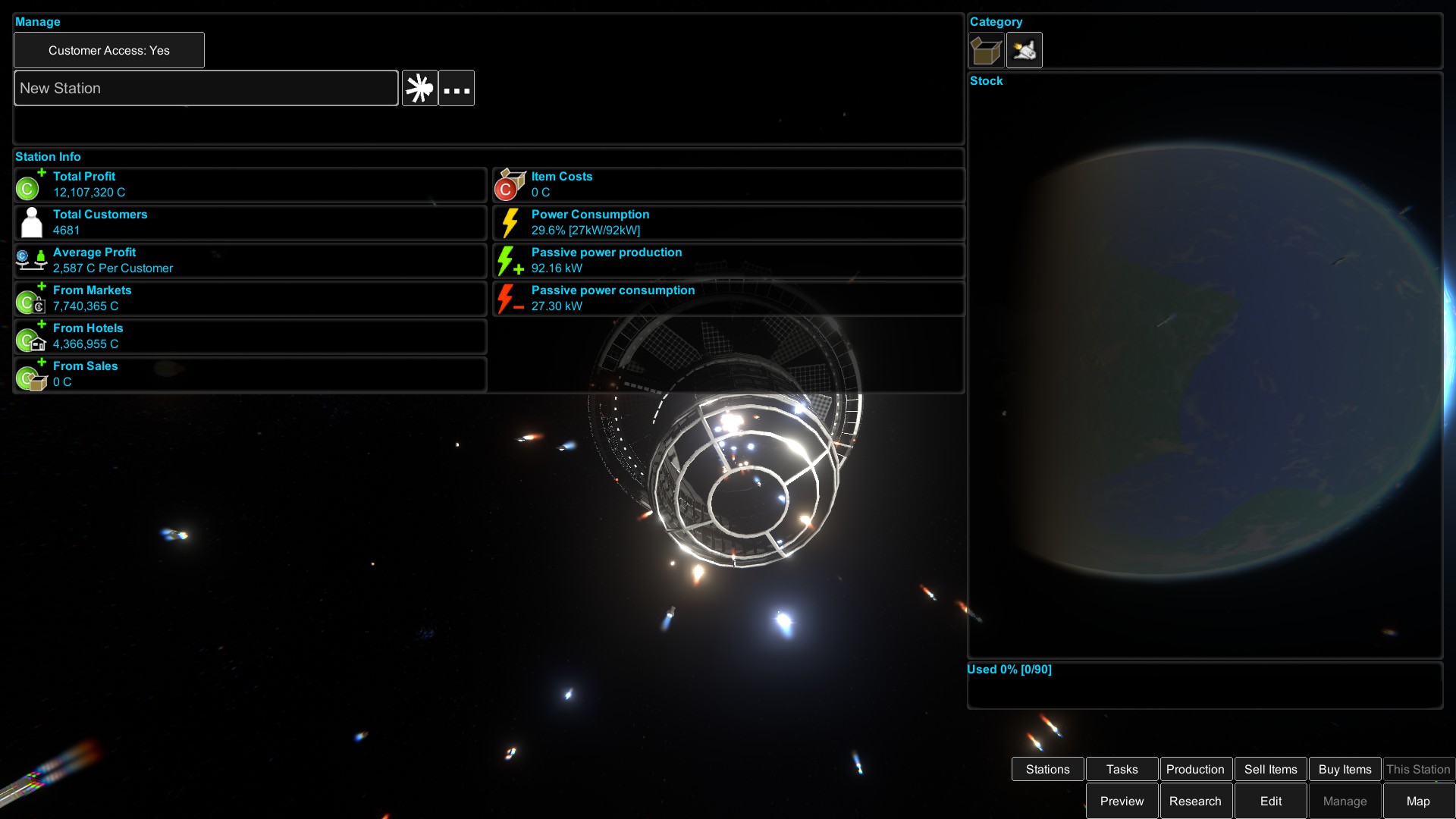
Many “Tycoon” games that recognize this problem tend to just make the game about very short missions that have esoteric, non-money related goals. (For example, the original Roller Coaster Tycoon would just be about making a single roller coaster per mission most of the time. The Sierra City Builder games like Pharaoh were about missions to build larger cities in increasingly more crowded and complicated maps.) Games that have you running a single business for a long time need to be about something other than simply maintaining solvency, include significantly more dynamic economic simulations (so that a stock market crash or something can create market shocks that make old methods of making money no longer viable), or give up on the idea of having difficulty.
At this point, a major problem is I’m not entirely sure what the core gameplay loop of Space Station Manager is. Is this a physics simulation game like Kerbal Space Program? If so, it needs to get much more in-depth about its physics. Is this a city-builder-style game like the old Sierra games like Pharaoh? If so, it needs to have more serious city-building simulation and focus upon what goes on inside the stations. Is this a “Tycoon” game like it appears from the outside? Well, it needs to change up its gameplay loop to avoid the basic Tycoon game trap, then…
As it currently stands, unlike games like Startopia or Spacebase DF-9 or Starmancer, Space Station Manager has only the most abstract representation of the internals of the station. That is, it has inventory and a hypothetical number of visitors onboard, but no capacity to customize the internal layout of the station itself or make individual crew members with specific traits or talents exist or make there be any sort of internal ecosystem besides the balancing of resource and production chains.
The game seems focused upon external aspects, instead, letting you build dozens of stations in rapid succession. Making stations is easy, instantaneous, and always profitable if you add markets. (Who travels light years to another star just to visit the gift shop?! Who sets up a gift shop in the middle of deep space where it would logically take centuries at relativistic speeds to just get shipments of nick-knacks, for that matter?!) Gathering materials and refining them, however, takes shuttles, which takes materials and refining them. It’s an arduous bootstrapping process, but eventually, you can kinda-sorta get things running smoothly, although the current interface demands constant babysitting of production chains.
Kerbal Space Program and to a lesser extent, Nimbatus, are games about space focused upon the physics of the rockets and drones, tasking you with engineering. Space Station Manager currently has no indication that it will ever give you the ability to meaningfully customize stations in manners other than adding modular components along a one-dimensional axis, meaning that there is merely a mass cap based upon materials, so physics is not terribly meaningfully integrated except as a construction cap.
The only thing that seems to remain is some sort of trading game, in the vein of the Kalypso games like Port Royale. There is at least the bare infrastructure of being able to gather raw materials, set up factories, and then distribute them, although the game will need radical redesigns of the user interface to make the game more user-friendly for scripting the kind of trade routes you see in games like Port Royale.
Tech Trees in SPAAAAAACE
In the absence of anything better to do with your time, the main focus of playing winds up being unlocking technology.
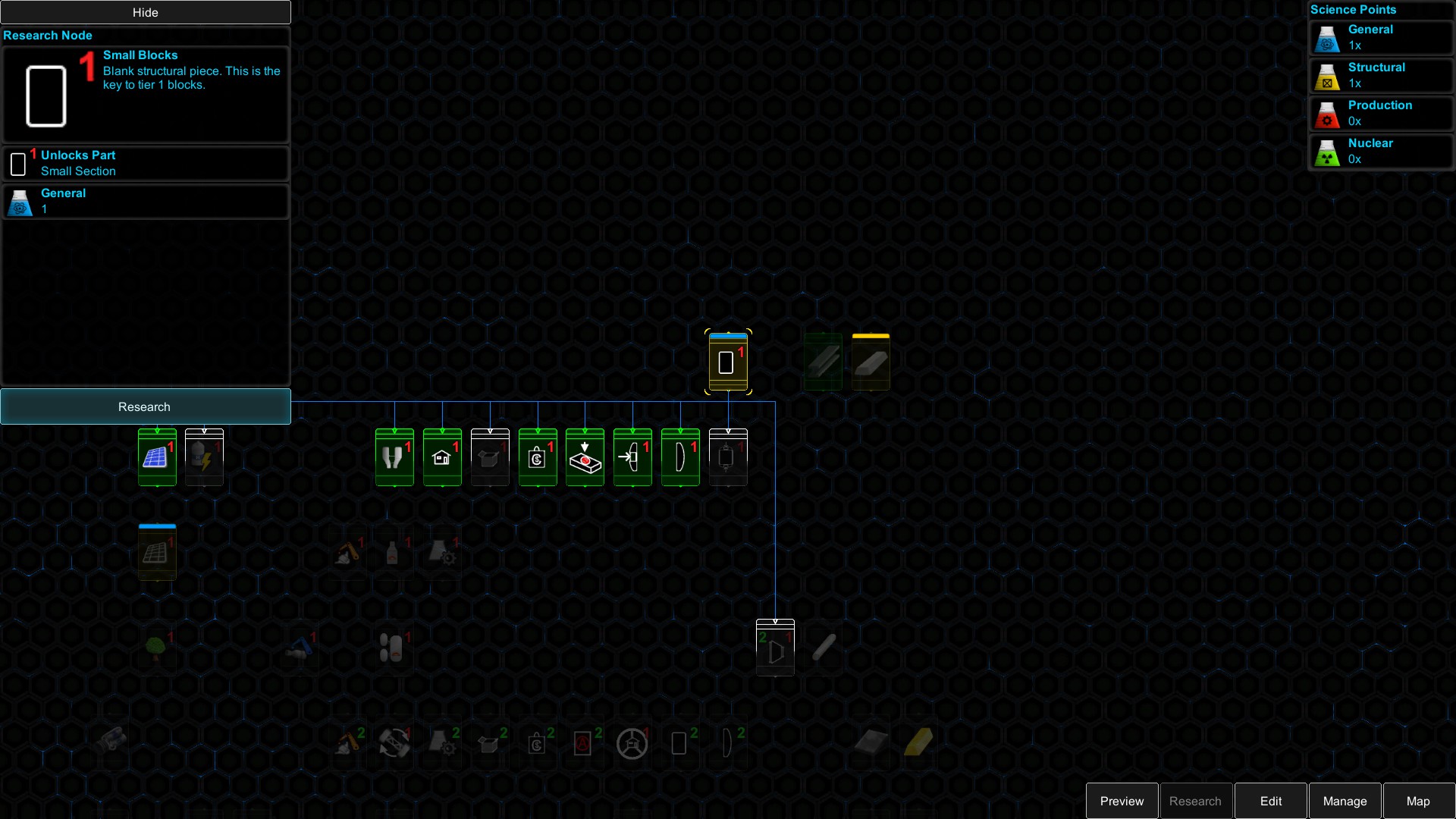
The game starts with almost nothing unlocked, even things that logically should be a per-requisite for getting into space in the first place, like discovering how to manufacture aluminum.
At the start of the game, you have no means of gaining research points except through the observatory and building stations that orbit exotic locations. At first, you are entirely reliant upon solar power, but as long as you build close enough to a star to power the solar panels, you can set up an observatory with a hotel and gift shop anywhere. Building more than one observatory-equipped station in the orbit of a single astral body drastically cuts the amount of research an observatory can obtain, but there’s nothing stopping you from putting an observatory around the pulsar several light years away from the Sun right from the start of the game to get drastically more research than you’d get just putting a station around the Moon.
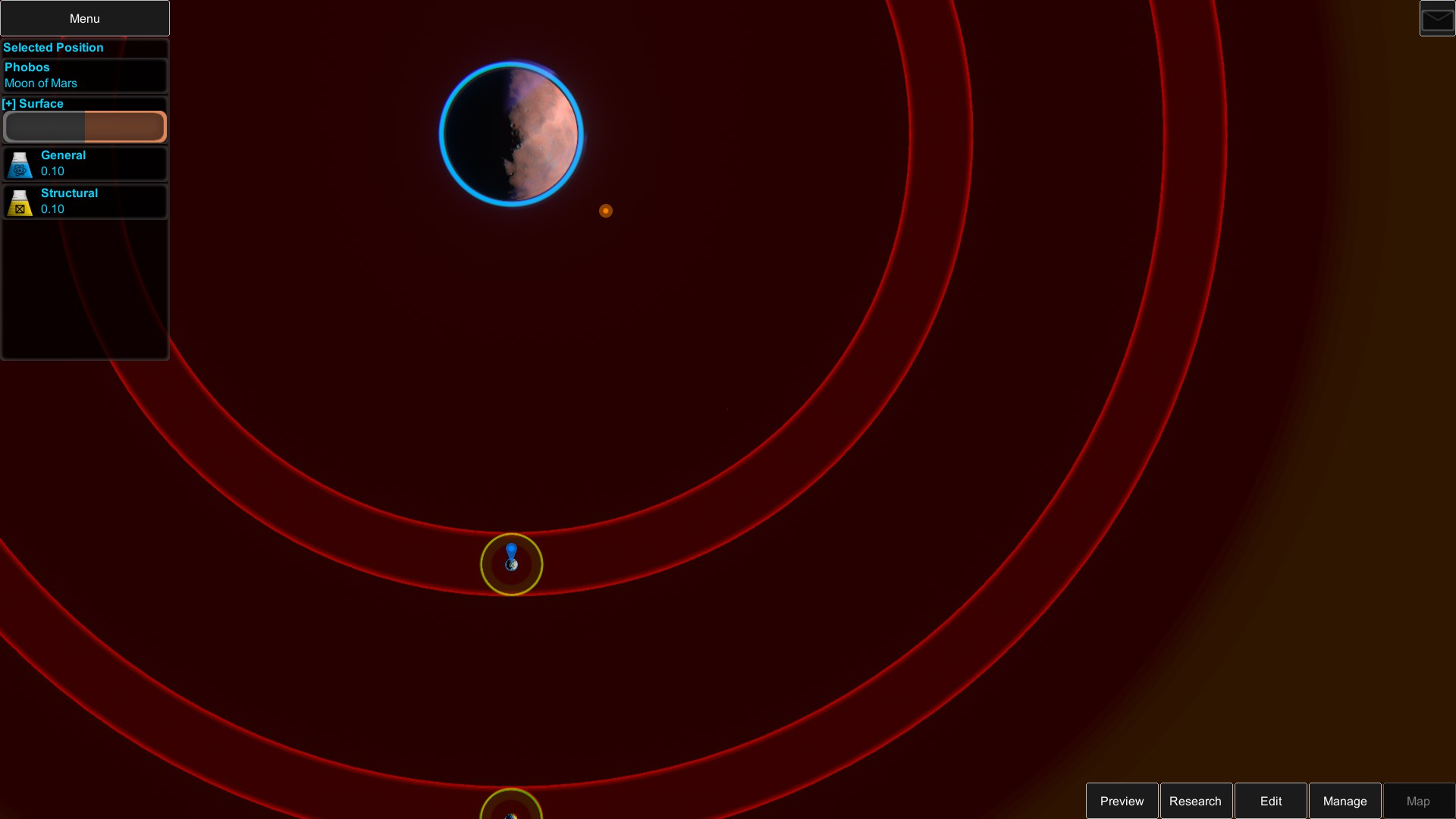
Beyond simply passively observing, there is an “experimentation” module, which destroys materials to turn them into research points. Rarer/higher-tech materials like diamonds give you vastly more research than basic materials like ores, but the amount of research provided declines with each material sacrificed. This is your best means of gaining more research, but because it constantly demands new kinds of materials you can only make with higher technology, it starts to become a Sisyphean task gaining research points to spend on technology you use to make materials you sacrifice for more research.
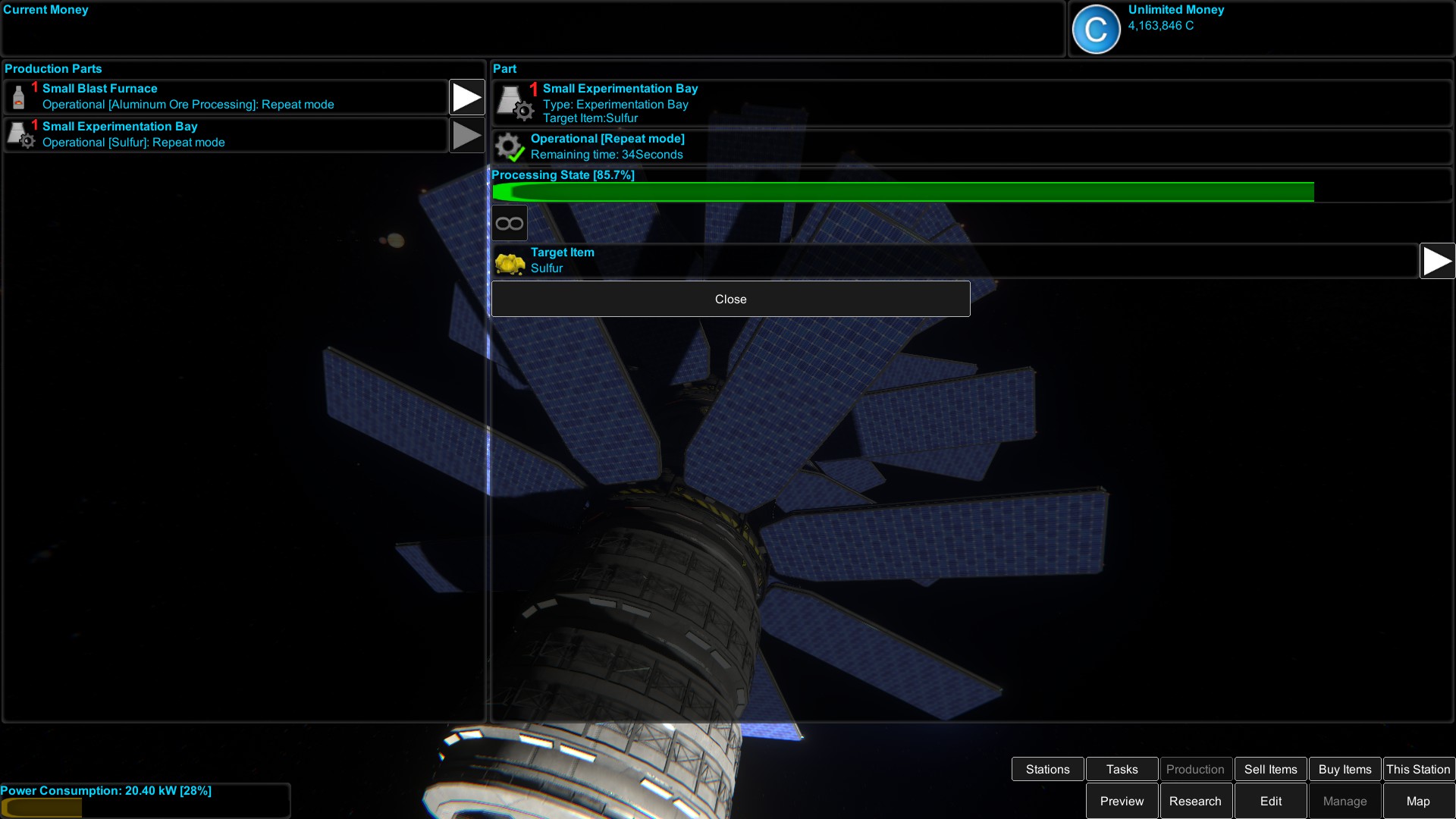
Interface
So, it’s that time again. Time for me to explain why another indie game is completely ruined by an interface that is so frustratingly difficult to use that it kills all enjoyment to be found in the game.
Well, let’s start with the classic: There are no rebindable keys. Say it with me now, kids: There’s no excuse not to have rebindable keys in a PC game. It takes minimal effort on the part of the developer, but can make the game vastly easier for players to play the game. Not everyone has a QWERTY keyboard or uses WASD primarily. In fact, there is no indication of what keys do at all, which is another major problem.
Besides the construction of the station parts, which is moderately clunky but otherwise fine, all aspects of station management are performed via buttons and menu tabs. These partition the information you need to know from the screens where you can act upon that information for no good reason. For example, you cannot see what materials you have or how much space remains on your station for materials on the screens where you control sending out shuttles to get more materials. You need to go back to the research tab to find what research you have and what you need, and you can’t see what experiments will give you any particular kind of research without manually going through the experimental bay production manager material by material.
Worse, there is no way to see any relevant information about stations without shifting focus to that station. Doing this takes either finding it on the map (and constantly zooming in and out on the map is a real pain), or going to “Manage” -> “Stations” -> clicking the station in particular from the big list of them -> clicking the “manage” button on that drop-down -> going to the tab that shows the information you wanted (which may take two or three clicks, as well). Things that should only take two or three clicks and less than a second wind up taking a dozen clicks and five to ten seconds to find out, and when I’m spending nearly all my time just trying to find out what the heck my stations are doing, this starts to really become tedious.
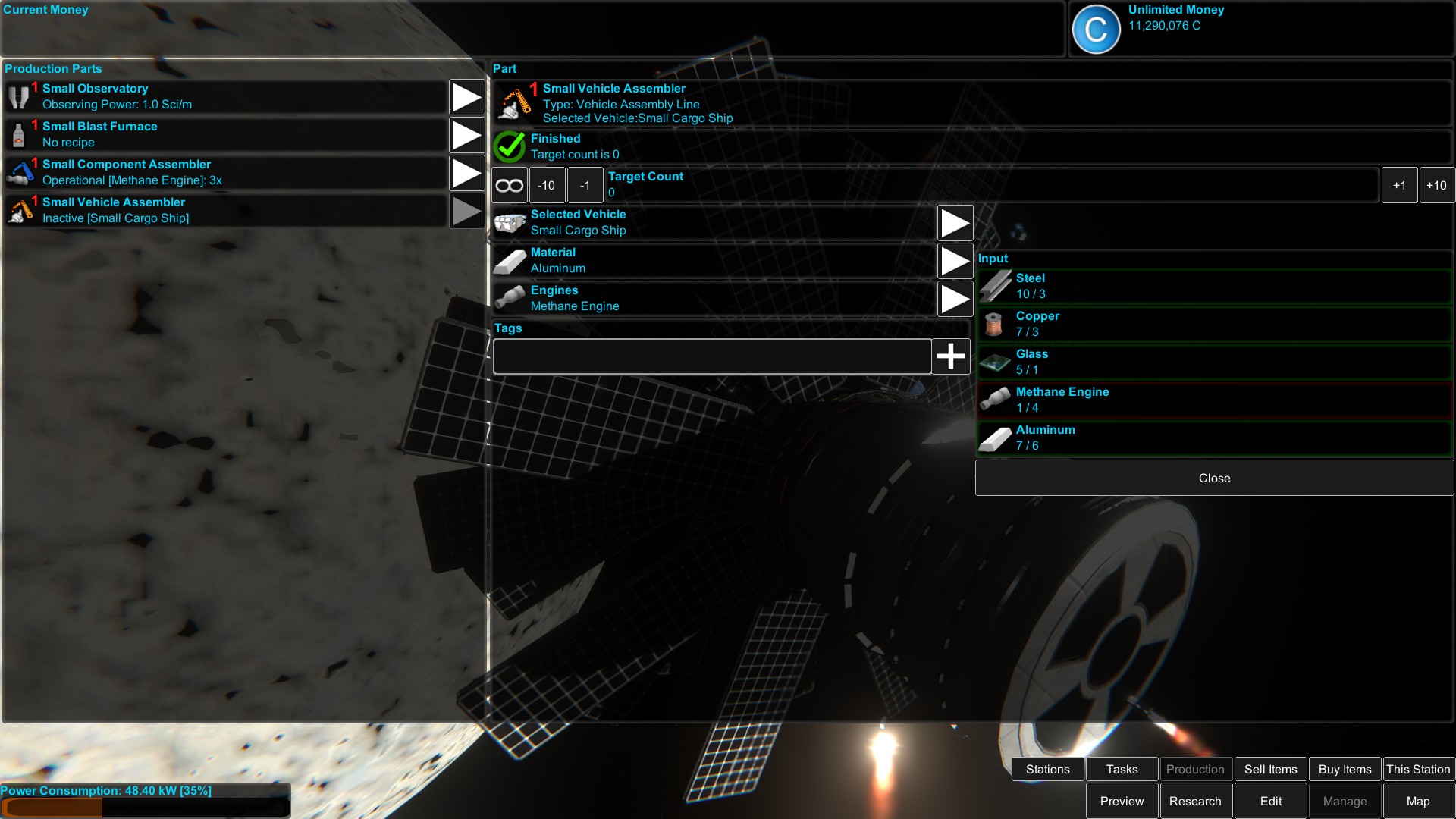
Production is a major problem because many things you want to build require multiple types of materials, which requires multiple different manufacturing chains. Foundries are heavy, so you only want to have one per station, but there’s no way to set up a foundry to have more than one task at a time the way that shuttles can. This means that, once again, you need to manually watch the material levels in each station engaged in production, and change the foundries over to making whatever products you have materials to make.
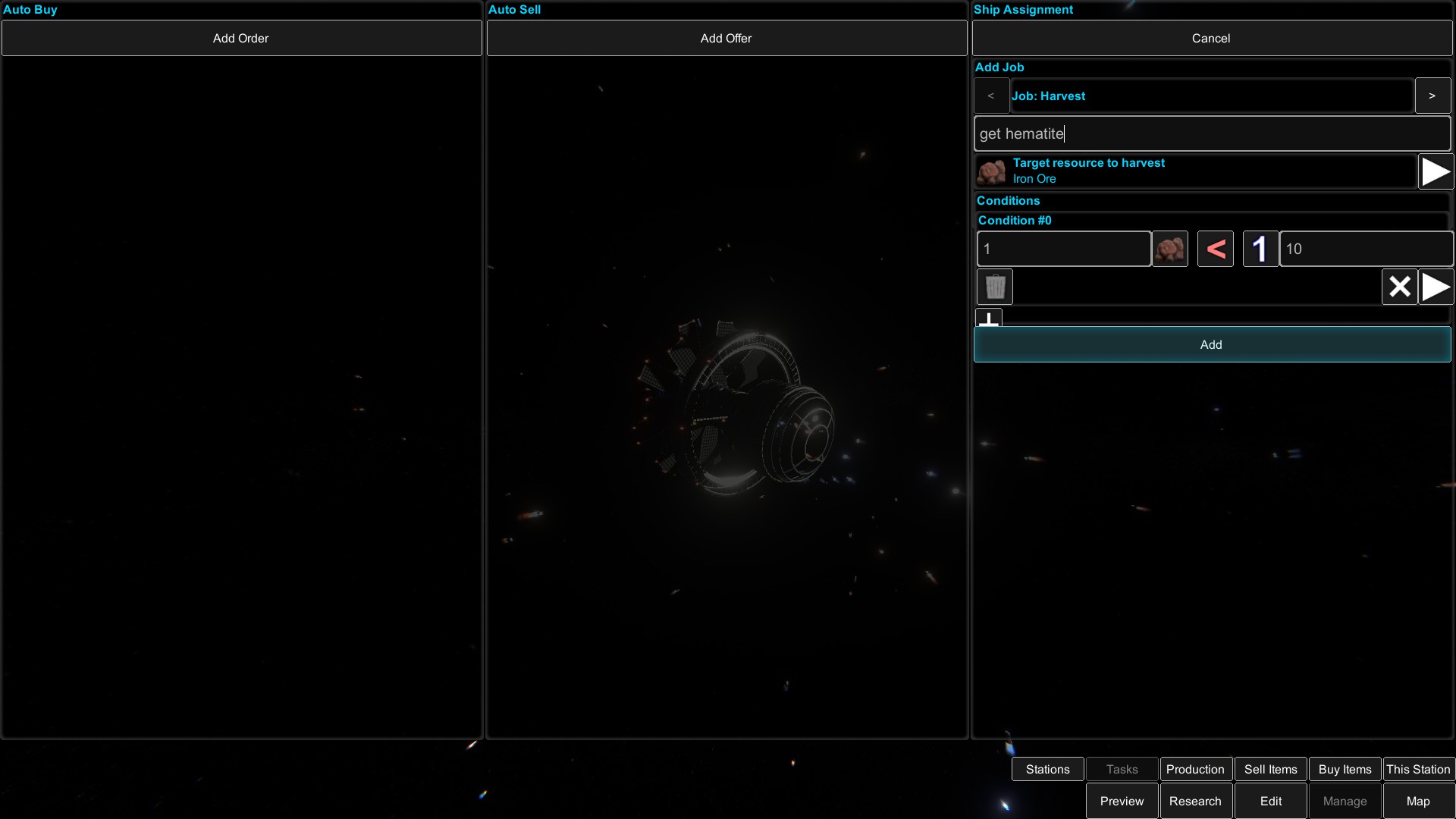
On the one hand, the shuttles get a scripting language that allows you to set up potentially fairly complex instructions to make your production chain partially automated. On the other hand, the scripting is bugged, and changing a new script’s conditions will overwrite conditions on a script you previously created for some reason. In other words, it’s bugged in this version of the game and impossible to actually use the scripting to do things like send out your shuttles to get more iron ore when you run out of iron or get more aluminum when you’re out of aluminum. You need to fall back to babysitting the levels and manually assigning orders, anyway. Did I mention that manually babysitting the production chain that should be automated is basically the only thing you do in this game?
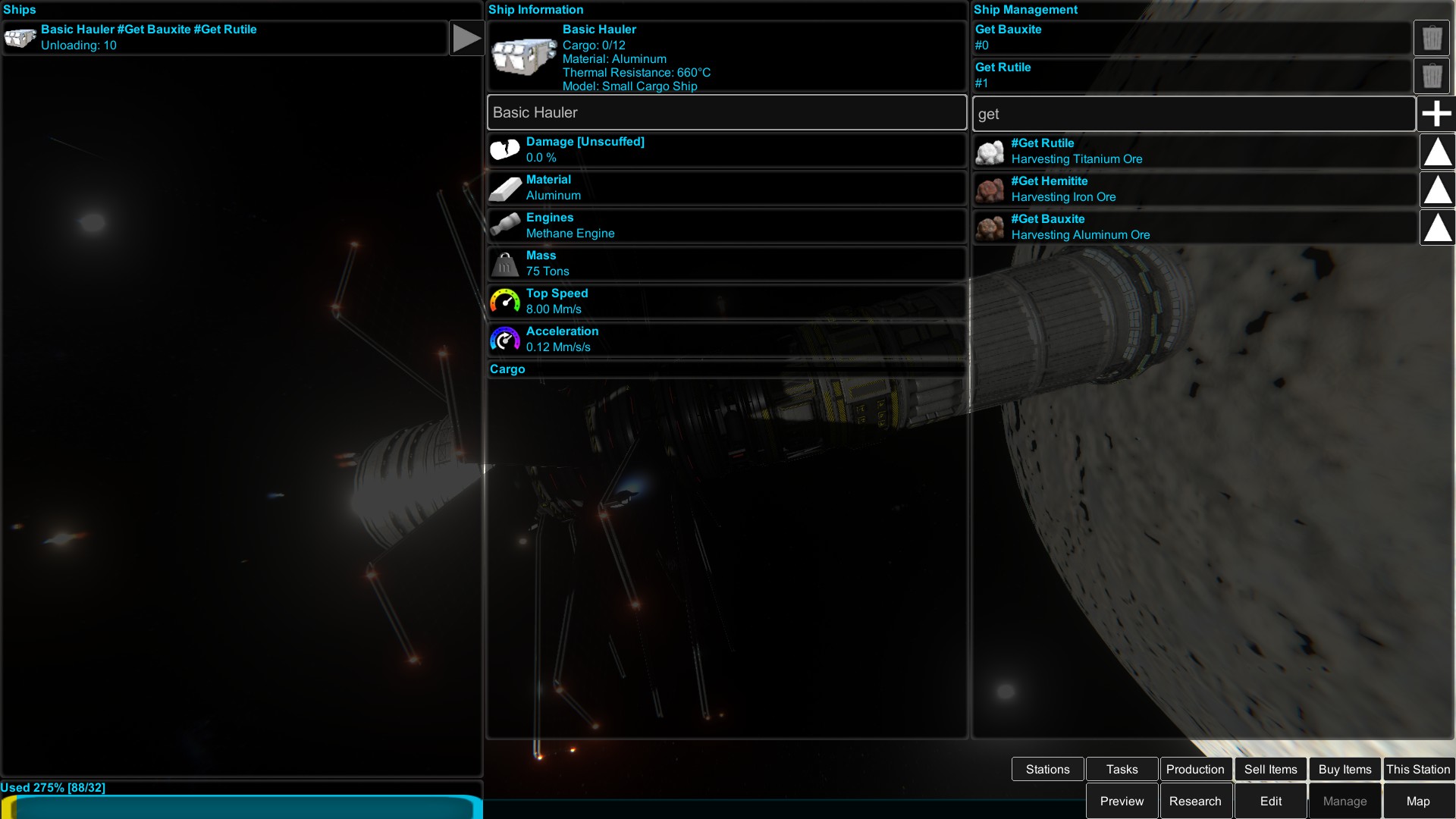
One major problem is that, besides “harvest”, there are two other task types, “transfer”, and “transport”. One ferries goods over to another station, the other reassigns the shuttle to a different station. Notice how these two words are extremely similar in both spelling and meaning, potentially making for a totally unnecessary amount of confusion? It’s easy to accidentally reassign a shuttle and have to wait out the 33 minute trip one way and back when you just wanted to shuttle graphite around. If you forget where a shuttle is, you’re screwed, and have to go through each station one by one to find a leftover shuttle not doing anything.
The game desperately needs some sort of notification system to tell you when you run out of materials, have a shuttle that for one reason or another cannot do any of the tasks assigned, or otherwise have your production chain coming to a grinding halt. Every single aspect of this game demands your constant personal attention, and every part that tries to be automated breaks because of problems with the scripting.
No Tutorial
Compounding a poor interface is the fact that there’s also no tutorial. On the “Edit” tab, there are four hotkeys marked, but there’s literally no other instructions. For example, if there is a way to pause this game, I don’t know how to do it. I have to mash keys randomly until something happens, and I didn’t notice any pause effect. If there isn’t a way to pause the game, why isn’t there a pause button?! I’ve never played a management or strategy game I couldn’t pause outside of some always-online MMO-style game.
Similar to the problem with 5D Chess, the developer simply pinned someone else’s YouTube video and used that as the closest thing this game has to a tutorial.
I posted as much on the forums, but as I said when it came to 5D Chess, this just isn’t an acceptable way to teach your game to players. Developers who do this often say something about how they don’t see a point in making a manual if the game is going to change, however this is absolutely backwards. Especially when you expect to have multiple updates that change key aspects of the game, you cannot rely upon users making your tutorials for you, as you’re constantly changing the game out from under them and making those user-made tutorials obsolete. Individual users will not keep up with every update a developer makes, so all these guides are going to become obsolete and cause constant mass-confusion in the forums.
For example, if I don’t use conditions (which are bugged) when setting multiple resource-harvesting tasks, how does a shuttle choose what to mine? Is it OK to leave it trying to mine three different things at once? Or does a shuttle pick one task (at random?) and only do that one harvest task at a time? It’d sure be nice to know these things…
For another example, many of the things you can research have identical descriptions. The game doesn’t let you save and reload, and you can’t un-spend research points, so it’s rather annoying that there is no useful description of what you’re paying for when you spend hours worth of research points to get an upgraded version of an experimental lab that has the exact same description as the tier one lab.
Graphics and Sound
For a game that seems to be developed by a single person, the graphics are rather good. The planet surfaces are still using rather sub-par textures, but the space station parts tend to look very good. Hence, this game tends to be mostly a “Space Station Screenshot Manager”. The community pages on Steam are just a chain of screenshots of different users’ stations.
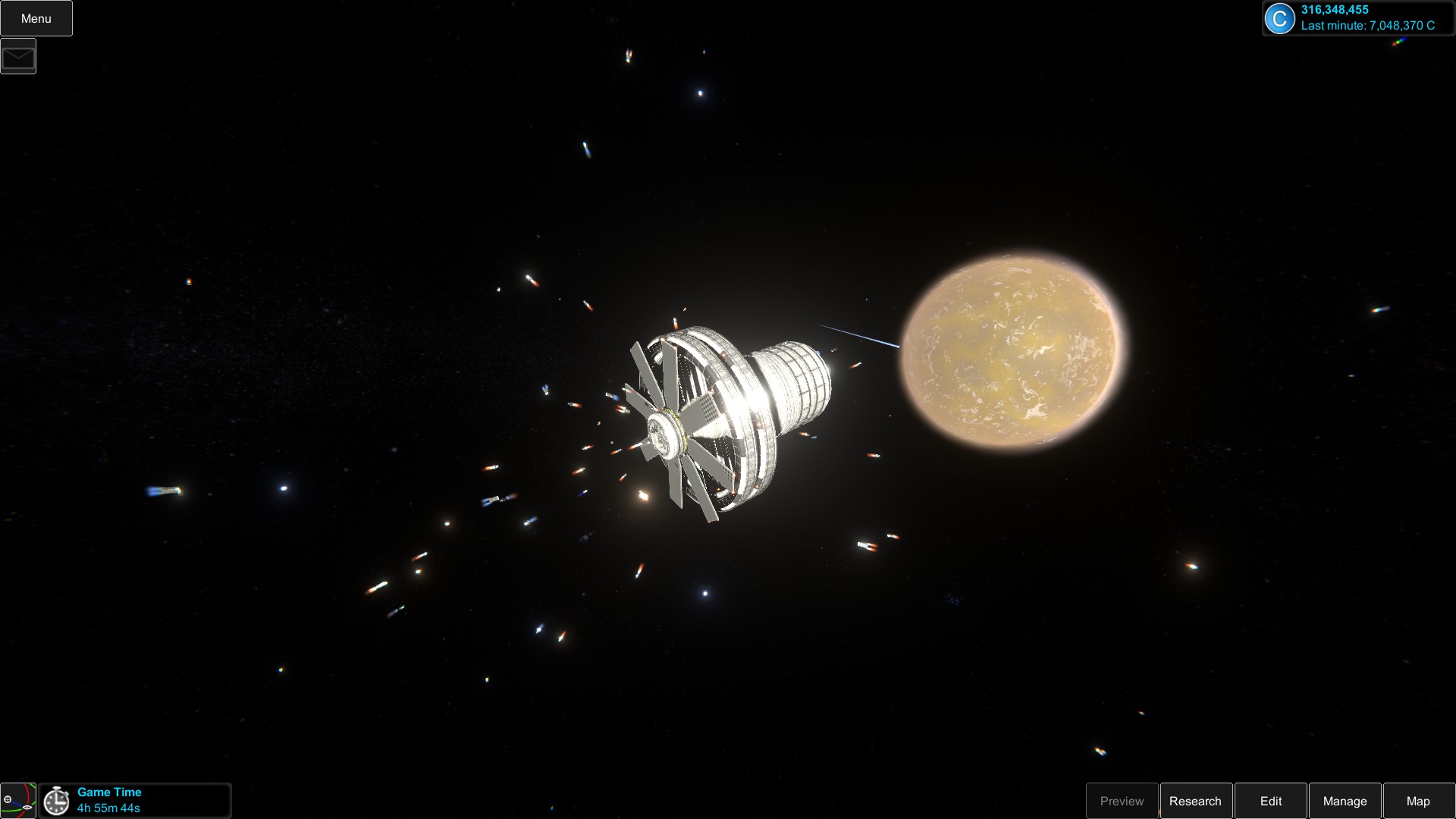
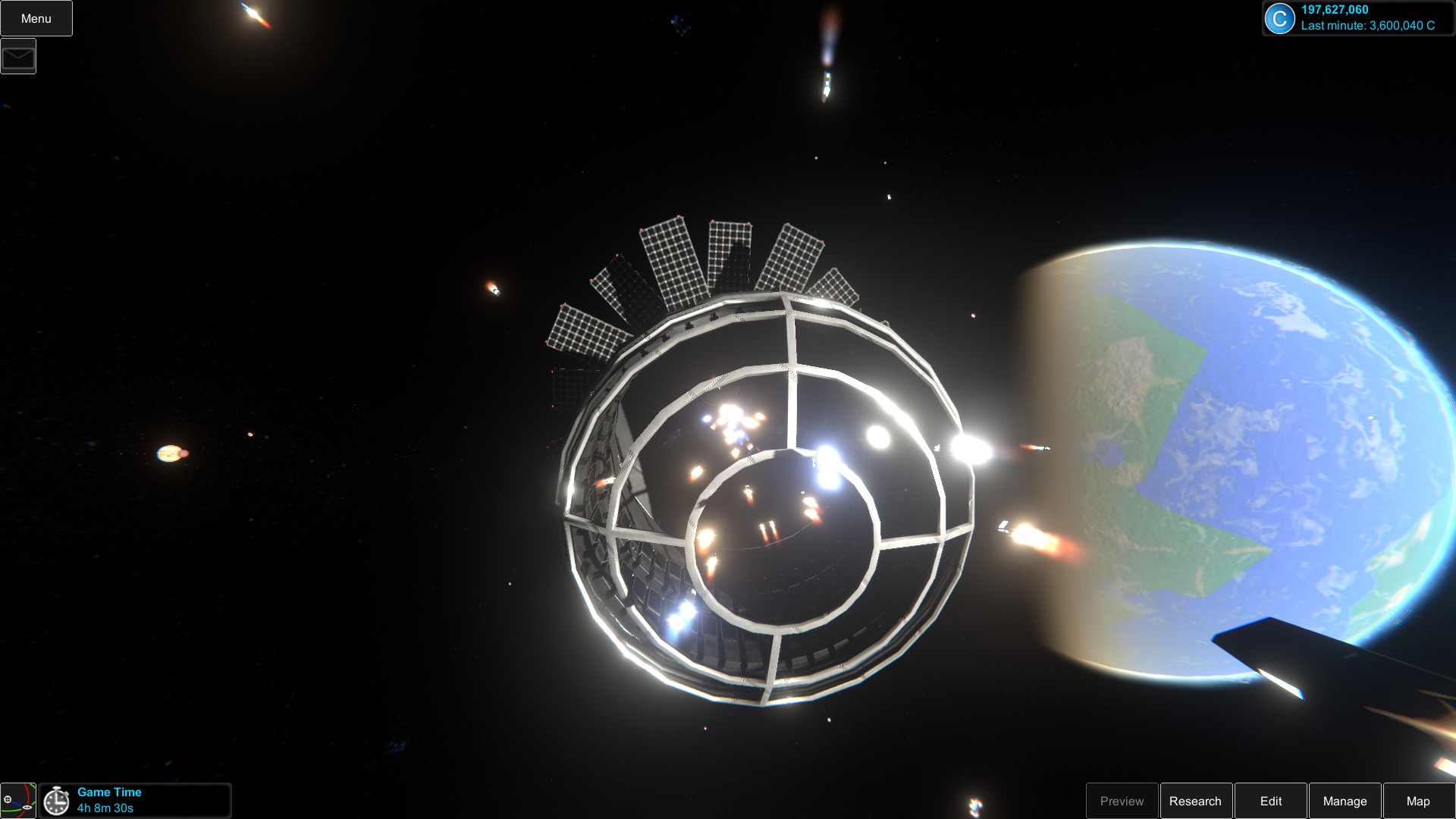
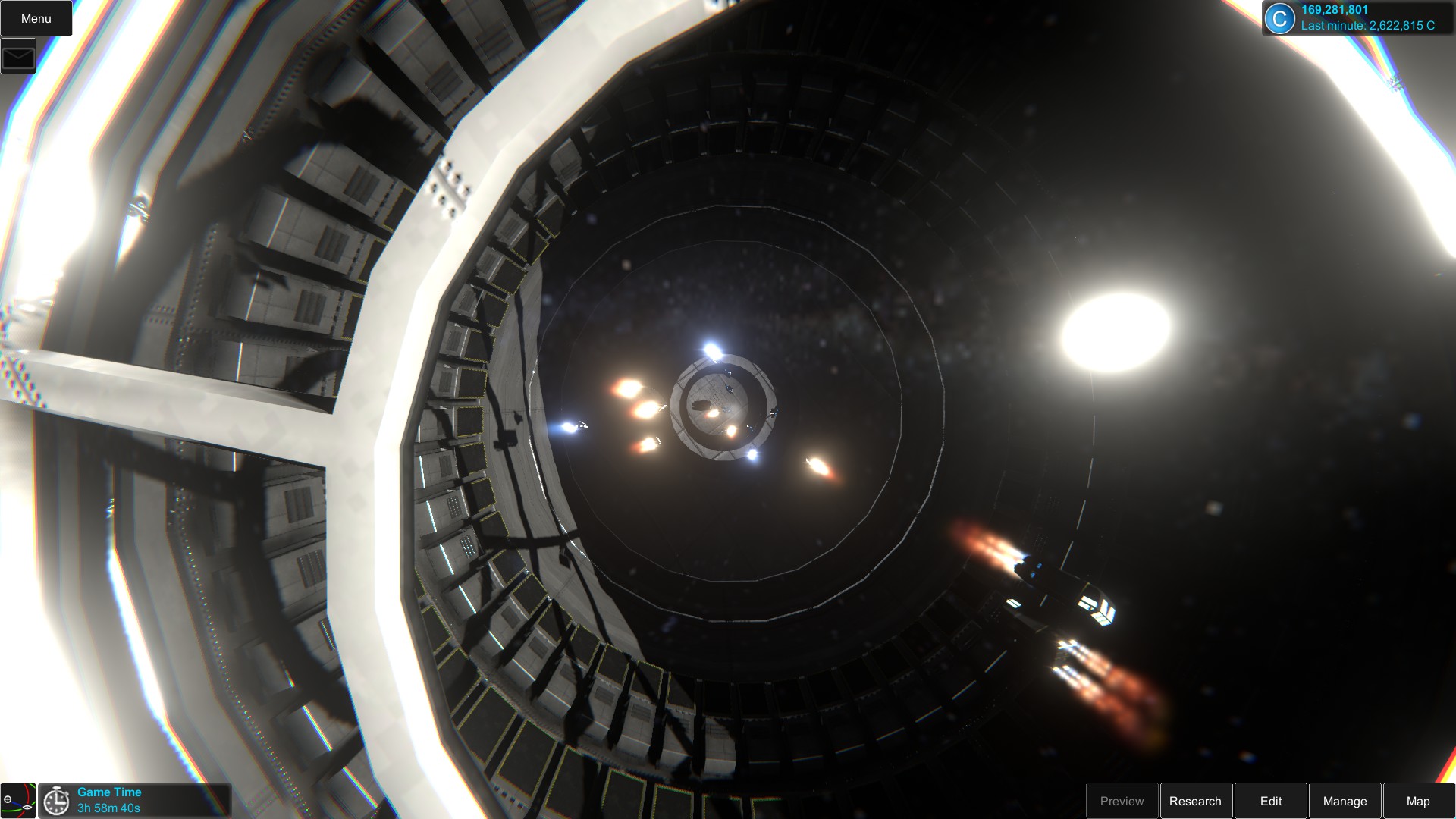
Sound-wise, as the video above demonstrates, there is no music, and the only sound effect you hear besides clicks of buttons is a nearly omnipresent sound that I presume is some sort of rocket thruster from the continuous stream of shuttles going into or out of your stations.
Generally, this is another game you’ll just have to play your own music over.
Verdict
As it stands, this game is a space station screenshot posing studio. Purchasing the game at this point is a hope that it will help keep the developer actively developing the game, and to stay abreast of updates or have feedback for the developer, so consider it effectively like a Kickstarter backing more than a normal game purchase. It will likely be at least a year before the game will shape up into something you can properly play, much less actually be complete.

